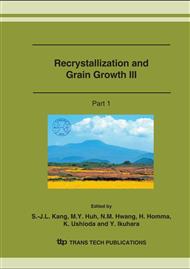p.1163
p.1169
p.1177
p.1183
p.1189
p.1195
p.1201
p.1207
p.1213
Phase-Field Modeling of Recrystallization - Effects of Second-Phase Particles on the Recrystallization Kinetics
Abstract:
The effects of second-phase particles on the recrystallization kinetics in two-dimensional polycrystalline structures were investigated. Numerical simulations of recrystallization were performed by coupling the unified subgrain growth theory with a phase-field methodology. Simple assumptions based on experimental observations were utilized for preparing initial microstructures. The following results were obtained: (1) The presence of second-phase particles retarded recrystallization speeds. (2) If the mean subgrain size was small enough recrystallized region covered whole system for various values of the particle fraction, f. (3) On the other hand, if the mean subgrain size was not small enough the progress of recrystallization was frozen at some point.
Info:
Periodical:
Pages:
1189-1194
Citation:
Online since:
October 2007
Authors:
Price:
Сopyright:
© 2007 Trans Tech Publications Ltd. All Rights Reserved
Share:
Citation:


